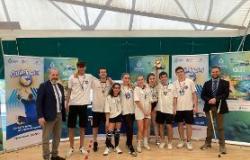Landing a spacecraft on the moon is no easy task, even for NASA. Over billions of years since it formed, the moon’s surface has been reduced to a sandy mess of mineral fragments known as lunar regolith, a fine particulate that can damage cameras, rovers, and even orbiting vehicles once it’s stirred up by the fiery plume of a descending rocket.
As it embarked on the Artemis campaign to establish a permanent lunar base, NASA outsourced the design of solutions to address lunar regolith, asking college students from across the country to share their best ideas as part of the Human Lander Challenge. A group of mechanical engineering seniors from The College of New Jersey answered the call.
With their straightforward design, known as the TCNJ Adaptable Regolith Retention Platform or TARRP, the five-member team was selected as one of 12 finalists, alongside powerhouse engineering schools including the University of Michigan, the Colorado School of Mines, Texas A&M University, and Embry-Riddle Aeronautical University. In June, the team members will travel to the Marshall Space Flight Center in Huntsville, Alabama, to present the findings from their research and design to a panel of NASA and industry experts in a bid to win one of the competition’s top three spots and share an $18,000 prize purse.
“The lesson we learned as a group is not to underestimate your potential,” said the team’s adviser, Mohammed Alabsiassistant professor of engineering.
While many of their competitors could conduct their work with bountiful resources in advanced laboratories, the TCNJ team — composed of co-leads Christian Katsikis and Aidan Wiehealongside John Hardie, Harry Brierand Matt Walsh — had to make the most of what they had available. With a budget around $7,000, including about $5,000 from the college and $2,000 from the New Jersey Space Grant Consortium, they opted for a seemingly basic design that nonetheless impressed NASA’s reviewers.
The TARRP is a heat-resistant platform made of solid carbon composite that can absorb and deflect the plume of a rocket, which can reach up to 3,000 degrees Kelvin so that no lunar regolith is disturbed. To test it, the team built an acrylic vacuum chamber to fill with simulant regolith to assess what will happen when a rocket inside the chamber is ignited and obstructed by the TARRP.
The easiest approach to the challenge was to avoid any interaction between the plume and the surface, Wiehe said. Rather than attempting to design a long-term solution, the TARRP is intended as a temporary landing pad for NASA, “in lieu of something that requires more infrastructure,” he said, making the proposal easier to develop and activate than many other ideas.
“It made the most sense for us, given our resources, to do something mechanical and relatively simple,” Katsikis said, adding that working with limited resources was a strength, rather than a weakness, because it encouraged creativity. The team called upon their education in mechanical design, thermal fluids, and kinematics over the course of months of research and iteration across the fall and spring semesters.
“Although the design might seem simplistic, it serves the purpose,” Alabsi said. “We don’t have to overcomplicate it. Engineers are supposed to make things easier.”
The TARRP team still has several weeks to test its design before submitting a technical paper to NASA in June, followed by a 25-minute presentation and 20 minutes of questioning in Alabama on June 26, after which the winners will be announced. Their contraption weighs more than 200 pounds, so it won’t make the trip with them, but a 3D-printed replica will likely accompany their journey.
On a recent spring day, the students lit their AeroTech G80 rocket on the sidewalk outside Forcina Hall to determine how to locate the rocket from the base of the vacuum chamber during future testing and analysis. Its 16-inch plume exceeded their expectations — a small-scale indication of the challenge NASA faces. “It was just a few seconds, but it was really loud,” Wiehe said of the ignition.
Even with their proposal selected as a finalist, the students still have plenty of work to do. The project has required continuous research and skill development and is only now approaching the demonstration phase that will allow them to make final calculations and estimates to share with NASA. But they’ve already shown that their work can stand up against some of the country’s brightest students and most well-respected institutions.
—Ben Seal





